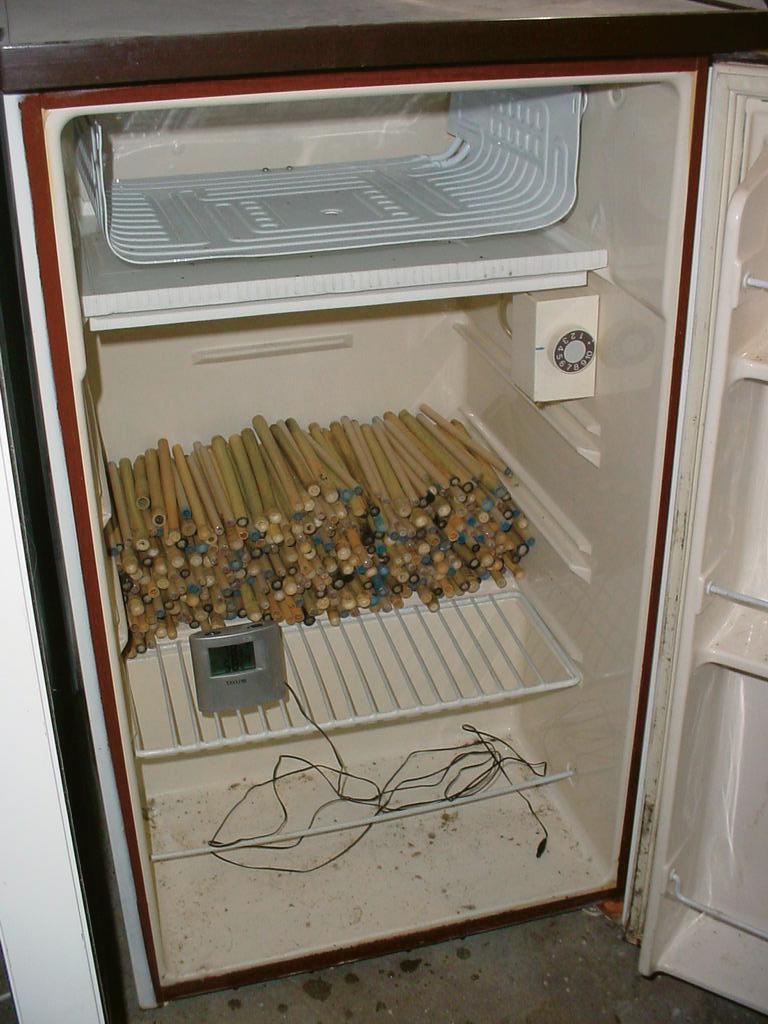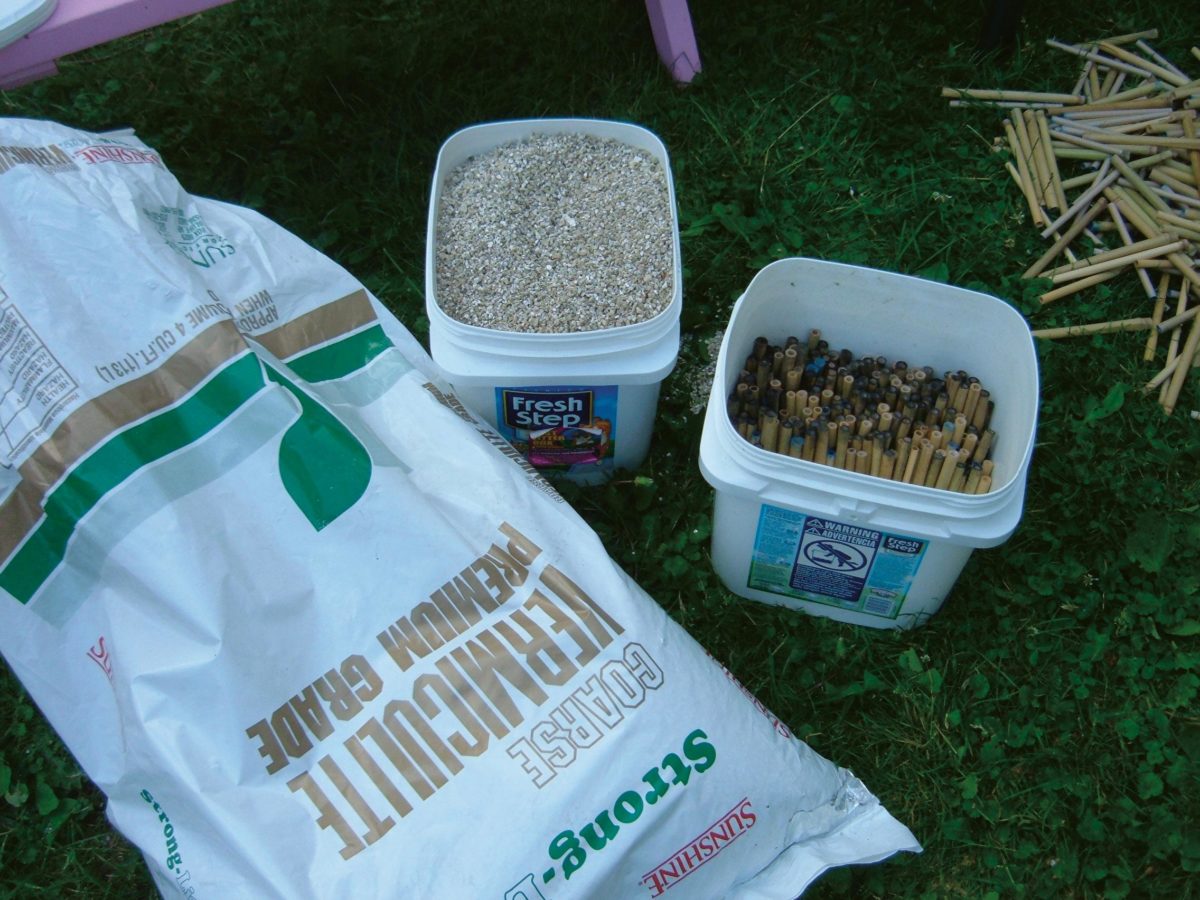Following nesting, larval development continues within the nest tunnel for several months with pupation occurring in late summer for BOBs and hornfaced bees. Adulthood is reached in autumn with the exact timing dependent upon local conditions. During this process cocoons can be randomly examined by careful dissection or x-ray analysis (see Appendix B) to monitor growth stage and overall health.
Development occurs rapidly at warmer temperatures compared to lower temperatures. A rearing regime at the USDA Bee Lab in Logan, Utah produced adult bees in 63 days when larva were kept at 84°F (28.9°C). Bees maintained at 64°F (17.8°C) took nearly twice as long, 123 days, to reach adulthood. Developmental temperatures maintained in the mid70s (°F) (~24°C) are probably close to ideal. Fluctuating temperature regimes with a daily cycle of 8 hours at 57°F (13.9°C) and 16 hours at 81°F (27.2°C) have also been used on BOBs with success.
Faster development generally results in lower larval mortality. However, pre-wintering adults stored at warm temperatures for extended periods maintain high metabolic rates. Such bees may use up their stored fat reserves and literally starve to death during the winter or emerge as weak adults the following spring—often unable to fly or even chew out of the nest. To prevent energy depletion, BOBs and hornfaced bees should be cooled within two to four weeks of reaching adulthood.
Under natural conditions with locally native bees, this is usually not a problem. For example, BOBs can usually be stored outdoors in an unheated, sheltered location over the winter—unless the population was obtained from a significantly different climate.

With non-local bees, artificial rearing conditions are required. Hornfaced bees for example are believed to have less tolerance for subfreezing weather and should be maintained under controlled conditions in most areas.
Winter dormancy, or diapause, is required for emergence. The lengthy period of exposure to cold temperature ensures that bees emerge the following spring in synch with blooming plants. For BOBs from most areas of the US, the required length of diapause is normally between 100 to 200 days of cold exposure. Practically speaking, BOBs placed into cold storage in October are normally ready for emergence in April or May the following year. The diapause requirements for hornfaced bees are likely somewhat shorter.
When using artificial cooling, dormant bees should be stored between 35° and 40°F (~1.7° and 4.4°C) at about 50 percent relative humidity. Standard kitchen refrigerators are fine, but they should be used with an indoor/outdoor thermometer (Figure 6.20). By placing the outdoor probe inside the refrigerator, the internal temperature can be monitored without opening the door. Humidity inside the refrigerator can be maintained at adequate levels by maintaining an open tray or pan filled with water. Rather than placing bees directly into cold storage, they should be gradually cooled over a period of several days.
Wherever dormant bees are stored, it is imperative that the areas be free of rodents. Storage containers should be opened periodically to allow fresh air to enter and to prevent the growth of mold. In non-refrigerated conditions, bees should also be protected from parasites. Common methods include covering nest materials and loose cells with a layer of vermiculite (Figure 6.21) or storing inside a nylon stocking. Keep in mind, however, that if your bees are infested with parasites, these measures may prevent parasites from dispersing.
In addition to physical barriers, light traps are an effective tool against some parasites, including the extremely destructive chalcid wasps. Light traps consist of a black light suspended above a pan of water. A small amount of detergent should be added to reduce surface tension. Parasitic wasps and various nest destroyers are attracted to the light where they fall into the pan and drown. Light traps should be placed on the floor of the storage area, as chalcid wasps are poor fliers. Similarly if the storage area is a darkened room, a single window can be substituted for the black light. It is imperative that light traps— if they are used in the spring—are secured to prevent accidental drowning of emerging bees. For more information about mason bee parasites and diseases, see Appendix A.

Manipulation of diapause and emergence is an area of ongoing research. The ability to time bee emergence to peak crop bloom is essential if mason bees are to be maintained as managed pollinators. This is especially critical when using non-local bee populations for crops that bloom very early in the season (such as almonds) or crops that bloom late in the nesting season (such as highbush blueberries).
Close monitoring of bud swell is necessary when determining the need for bees. For most spring blooming orchard crops—such as apples, pears, and cherries—BOBs and hornfaced bees can simply be removed from cold storage one to two weeks before the anticipated bloom with satisfactory results. Emergence will occur over a period of a week or more.
For slightly later spring blooming crops, bees can be safely maintained in cold storage for one to two months longer than the natural emergence period. Extended chilling results in faster emergence, and some male bees may begin appearing in the cooler. Prolonged cold storage will negatively affect bee survival. The upper limit of safe chilling of BOBs and hornfaced bees is probably not more than 220 days. Bees cannot be maintained in cold storage for more than one season.
Advancing natural emergence is often required for very early blooming crops, such as almonds. In these cases bees can be artificially incubated, as is commonly done with alfalfa leafcutter bees.
During incubation, filled nests or loose cells should be placed in clean, ventilated, escape-proof containers. Incubation rooms should be well insulated and have sufficient air circulation to prevent hot or cold spots. Rooms should have adequate shelving to hold boxes containing loose cells or filled nest blocks. Dark rooms are also preferable because they reduce stress on the bees and can be used with light traps for parasites, as described earlier.
Room temperature, 68° to 72°F (20° to 22°C), is often adequate for incubation. However, more rapid emergence can be achieved with slightly warmer temperatures, between 72° to 84°F (22° to 29°C). Temperatures higher than 90°F (32.2°C) can be lethal to developing bees. In addition, relative humidity lower that 70 percent can result in developmental deformities. A normal household humidifier can be used inside the incubator. Light traps to control parasites will also add to the overall humidity.
Under these conditions, the first male bees will emerge within 24 to 48 hours if they have had an adequate chilling period. Female emergence follows several days later.
Incubation containers may employ a “bleed-off system” where bees are removed upon emergence and placed back into cold storage until release. Such systems consist of a dark box with a single exit hole leading to a screened cage. As male bees emerge they are attracted to the light outside of the box and gather inside the cage. The cage is then periodically checked, and accumulated bees are placed back into cold storage at the same temperatures used for winter storage. Cages should be checked several times a day.
When the first female bees begin emerging, the now docile chilled male bees and the remaining nests are transported to the field for release. If the bloom period is delayed by weather, the entire population can safely be placed back into cold storage at this point for up to a week if necessary.
Before release, the chilled bees should be placed back inside the incubation container (or a similar phaseout structure), forcing them to again emerge from a single exit hole—thus replicating natural emergence. Bees released in this way, however, are likely to have a higher dispersal rate than bees emerging directly from their natal nest in the field.
For extremely early advanced emergence, the rate of larval development must be increased so that bees can be placed into cold storage earlier (and thus be incubated earlier the following year). As mentioned earlier, larval development occurs more rapidly at warmer temperatures than lower temperatures.
A rearing regime to advance natural emergence of BOBs by two or three months has been developed by USDA Bee Lab in Logan, Utah. The procedure consists of storing recently constructed nests under a fluctuating temperature regime. A continuous daily cycle of 8 hours at 57°F (13.9°C) and 16 hours at 81°F (27.2°C) produced adult bees at about 70 days (as opposed to nearly 100 days under ambient outdoor temperatures). By advancing adulthood in this way bees are ready for cold storage sooner. Emergence incubation can begin after 150 days of diapause. This population will produce offspring which are also out of synch with local populations and weather conditions. All consecutive progeny will need to be maintained under the same artificial conditions.
Other diapause and emergence manipulation methods may exist, and research in this area is ongoing. Commercial bumble bee producers, for example, manipulate diapause by exposing dormant queens to high concentrations of carbon dioxide gas. This procedure is not widely understood and has not been reported with any Osmia species.
